
by jphilo | Oct 12, 2012 | Daily Life

The past week has been so hard on my perky, Pollyanna you’re-as-young-as-you-feel attitude, it left me thinking I’m plenty older than I feel.
The onslaught began last week with the birth of our first grandchild. Of course, that was a joyous occasion, and the man of steel and I are thrilled to be grandparents. But here’s what was the problem. When I tell people I’m a first time grandma, no one says, “Congratulations, but you don’t look old enough to be a grandma.” Rest assured, from now on, when people my age enter grandparenthood, those will be the first words out of my mouth.
Even if I have to lie through my teeth.
The next item to chip away at my inner Pollyanna was a picture in business section of the Sunday’s Des Moines Register. The photo was of Mike Wells, the CEO of Wells Blue Bunny Ice Cream, and it accompanied an article about the growth of the company. I read with interest because Wells Blue Bunny is located in my home town of Le Mars, Iowa. And I felt vaguely superior to the fit, grey-haired, and slightly balding CEO in the photo. Until I read the caption which said he was 53. So he was a measly high school freshman during my senior year at our mutual alma mater.
O-L-D neon lights started flashing in my brain.
The next blow was a Monday story on NPR about when senior drivers should give up their car keys. One expert advised adult children should initiate a conversation about the subject with their parents before those parents are 60 years old. That gives our kids only four years to screw up the courage to tell us we’re getting O-L-D.
No doubt, the person I cut off in traffic the other day agrees with the news story.
The final nail in Pollyanna’s coffin came this morning when the UPS man left a package, and I could not figure out how to open it. It was all rounded corners and tape. After cutting it open with a knife, I realized the box was a fold-over-and-insert-tab marvel of engineering, kind of like the houses we used to punch out of craft books and fold according to the directions to create a little village for paper dolls. Which made me feel even older because no one younger than me can envision those little villages or has any idea of what paper dolls are. Which leads to one final question: What good is it to be older than you feel, if no one notices you’re as young as you feel?
Please leave a comment, but only if it will put the perk back into this Pollyanna!

by jphilo | Aug 20, 2012 | Current Events

The Little Missouri winding through Teddy Roosevelt’s Elkhorn Ranch in North Dakota.
On August 7 during Morning Edition, National Public Radio ran a story about Theodore Roosevelt and the Little Missouri River. The story titled Roosevelt’s Badlands Ranch Faces Potential Threat gave the history of TR’s connection to the North Dakota Badlands and the Little Missouri. But the bulk of the article was an expose about how the North Dakota oil boom is threatening the wide open spaces of TR’s historic Elkhorn Ranch.
My grasp on the details is shaky because when I first listened to the piece and during each subsequent reading of it, the same questions pop into my head. Can this really be the same Little Missouri that meandered through Harding County and past Camp Crook, the town where Hiram and I lived and worked for seven years after we graduated from college? How did I miss the historical connection?
The answer, of course, is that we were young and ignorant when we moved there. Plus, we lived in Harding County, South Dakota, about 150 miles south of TR’s ranch. And once Allen was born, our lives got…complicated. Even so, I can’t reconcile our South Dakota Little Missouri and the surrounding countryside with the concerns about TR’s North Dakota Little Missouri and the land around it.
Because Little Missouri country was wide open in TR’s day, it was wide open when we lived there from 1978-1985, and it’s still wide open today. If you’re wondering how wide open it is, consider this.
We drove 90 miles to the hospital the night our son was born.
The first 55 miles of the trip were gravel back then.
They’re still gravel today.
And it’s not too far from the Mcfarthest Spot.
If you need more convincing, here are a few pictures I took during trips to Harding County in 2007 and 2010.
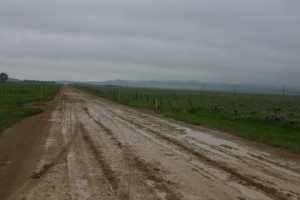
State Highway 20 west of Camp Crook, three miles from the Montana border. This is about a mile from the Little Missouri.
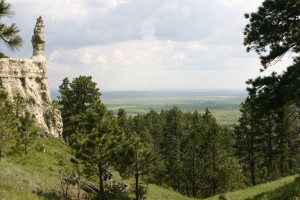
Custer National Forest, about five miles from the Little Missouri. The view reaches well into Montana, about forty miles.
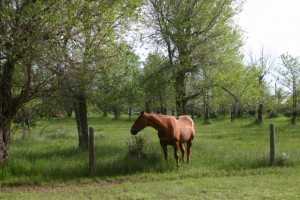
One of the horses on our friends’ ranch which is along the Little Missouri.
This country is big.
Wide open.
Huge.
No wonder I can’t wrap my head around the worries articulated in the NPR story. Not that they aren’t legitimate or newsworthy. They are. But there’s also a lot a land in them thar hills, and in my opinion, the story downplayed that fact to emphasize others.
There. I got that off my chest and feel much better. Except for one thing. Now I’m homesick for Harding County and all my friends there. I want to go to visit. But it’s a long way to drive.
About a thousand miles.
And the last fifty-five miles are still gravel.
On second thought, maybe I’ll wait to visit next summer.
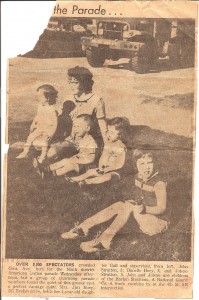
by jphilo | May 14, 2012 | Current Events, Reflections on the Past

NPR ran a story about an intriguing concept this morning. The host interviewed Taylor Jones, a 22-year-old who created the website www.dearphotograph.com. Here’s what Jones, in an article at www.npr.org says about how the website came about:
He came up with the idea last year while sitting at his parents’ kitchen table. While flipping though a family photo album, he stumbled across a picture of his younger brother, Landon. “It was his third birthday,” Jones says. “He had a Winnie the Pooh cake, and I was sitting in the same spot my mom was when she took the original photo.” Landon was also sitting in his same birthday seat. So, Jones held up the old picture — taking care to line up kitchen cupboards just so — and snapped a photo. He posted it on his blog, and the rest, he says, is history.
People can go to the website and submit their own photographs, all of which must begin with the words Dear Photograph.
Like I said, an intriguing concept. So intriguing, I started thinking about what picture I would like to rephotograph in the same setting as it was originally taken.
- One from our South Dakota days? Too far away.
- A wedding shot? Too unoriginal.
- A Kodak Instamatic shot of the Badlands from the famous camping trip with my uncle and aunt? Not sure where that one is.
- Something from my teaching days? No, they tore the school down.
Undecided, I opened iPhoto, and there was the scan of a newspaper clipping we found when cleaning out Mom’s house 3 years ago. The clipping records one of my earliest clear memories – the day my aunt took her two daughters, my brother, and me (I’m the one closest to the camera) to watch a parade in our home town. I don’t remember the parade as much as the newspaper photographer who shot the picture. I do remember how safe I felt with my aunt, how much help she said I was, what a big girl I’d become. Heady stuff for a middle child whose major talent at the time was tripping over her own feet.
The caption says 8,000 spectators watched the American Legion Parade that day in 1961. It also lists our names, ages, and the address of the corner where Aunt Donna found a quiet, shady spot (Central Avenue and Fourth Street SE) so we could watch the National Guard trucks rumble past.
Mom and I are going to visit Aunt Donna in a couple weeks. Maybe I’ll take the original clipping along, find that street corner, line up the clipping with the present day location, snap a picture, and submit it to www.dearphotograph.com. I know what to write beneath my submission.
Dear Photograph,
Fifty years has taught me it’s more fun to join the parade of life than to sit and watch it go by.
Jolene

by jphilo | Apr 27, 2012 | Current Events

A long, long time ago God invented mothers because He knew kids needed someone to:
- tuck them in bed at a decent hour so they could pay attention in school.
- remind them to be nice to their friends.
- shoo them outdoors to run around and get some exercise.
- make sure they ate 3 balanced meals a day.
- tell them to think a little while and see if they could figure out the answer for themselves.
- limit screen time.
- put them in the corner until they were done sassing and ready to treat people with respect.
- teach them to deposit half their allowance in the piggy bank so they learned to save.
- force them to drink water instead of pop because water is free.
- regale them with pregnancy stories.
- keep track of how often babies pee and poop and send older kids to sit on the toilet when they have stomach aches.
- tell kids to go upstairs and read a book ’cause they’re driving their parents crazy.
But according to yesterday’s episode of On Point (an NPR show hosted by Tom Ashbrook) entitled “The Quantified Self,” computer apps now can do everything mothers used to do. The webpage about the show lists the following what-your-mother-used-to-do apps:
- Sleep Cycle The Sleep Cycle alarm clock is a bio-alarm clock that analyzes your sleep patterns and wakes you when you are in the lightest sleep phase. It aims to make you wake up more refreshed.
- Facebook Timeline The social networking site now includes a timeline feature that puts your interactions with the site and your network of friends in chronological order.
- Fitbit A machine that tracks your sleep and physical activity.
- Meal Snap Take a photo of the food you eat and this app — amazingly — can figure out how many calories you’ve consumed.
- Honestly Now helps you make decisions by getting you the answers you want to your burning questions.
- What Pulse This app tracks your keyboard and mouse use.
- Mood Scope This app records your daily mood, tracks it over time, and can be integrated with your friends — with the aim of improving your well-being.
- Mint An online tool to track your financial transactions.
- Waterlogged This app keeps track of how much water you’re drinking each day.
- My Pregnancy Today Track your pregnancy with this app.
- Baby Connect records information about your newborn: feeding (bottle, nursing, solid, pumping), diapers, sleep, mood, activities, milestones, health, medicines, vaccines, photos, and more.
- Azumio This app measures and records your stress levels.
I am not making this up, According to Tom Ashbrook and his guests, almost everything mothers used to monitor can now be monitored and quantified by computer apps.
Why? Well, Tom Ashbrook didn’t say why (click here to listen to the show), but my guess is that grown up app creators prefer having a computer analyze their lifestyles and tell them to get enough sleep, eat right, and get off their butts and exercise than to have their mothers tell them the same things. Or point out the obvious: Companies aren’t interested in hiring people engrossed in digitized navel gazing. People obsessing over data about their sleep cycles, diets moods, bowel movements, water intake, and financial transactions don’t have a social life. So these app gurus are stuck in an endless, self-perpetuating cycle. They sit around creating apps about everything and anything except what they need to hear.
Stop navel gazing and think about somebody else for a change!
But God knew young adults need someone to tell them the truth now and then.
So he created an app for that.
And named her Mom.
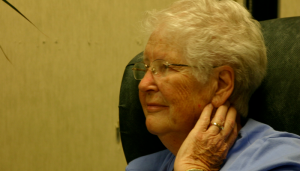
by jphilo | Oct 3, 2011 | Family

As a rule, this blog is a place where readers can come to relax and reflect. But today’s post will be an exception. Today’s post is issue driven, and we’re going to talk retirement. Why?
Because it’s important.
For the past three years, I’ve been helping Mom manage her finances. For the last two months, I’ve spent hours activating her long term care insurance and arranging for some in-home care three days a week. Sure, it’s a bit of a hassle, one more thing to cram into my busy days. But, it has also been much easier than what many families face because Mom has the financial means to meet her care needs.
Lately, I’ve been asking myself this question: Why is a former school teacher who raised three kids and cared for her chronically ill husband for 38 years in such good financial shape? Here are a few good answers:
- Because she took out exceptionally good long term care insurance many years ago.
- Because she pinched pennies throughout her life and saved diligently for retirement.
- Because as she worked, she wisely built up her pension income.
- Because my brother and sister-in-law share their home with her.
My siblings and I are all very grateful for Mom’s foresight and wise money management. We’re following in her footsteps, too. Hiram and I have long term care insurance policies (I think the sibs do, too), and we all save extra for retirement. And our kids are learning how to care for the elderly (that will be us in another generation) by observing how we treat Mom.
An NPR series about baby boomers and retirement that aired last week shows how rarely members of the upcoming generation of senior citizens engages in this kind of planning. If you haven’t done much retirement planning, you’ll want to listen to every episode of the series. But even if you and your elderly parents have planned well, the series is worth listening to in it’s entirely. The reporters present some really good information and highlight many of the resources I learned while helping Mom. How I wish I’d known it about three years ago!
If you’re convinced, here are links to the series, in the order they aired:
Retirement: Reality Not as Rosy as Expectations
Boomers’ Delusions about Health in Retirement
Saving for Retirement: How Much Do You Need?
What Is Retirement Anyway?
Forget Florida: Colder Climes Top Retirement List
After you read or listen to the stories, come back and leave a comment about what you read. Or share your best retirement planning tip. And rest assured, tomorrow this blog will be back to relaxing, reflective topics you’re used to…as long as our retirement plans keep holding out.









